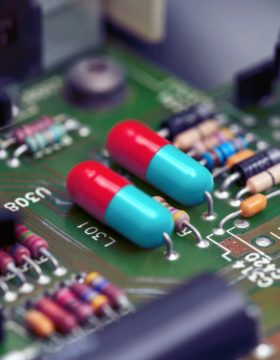Alice Park in Time:
 When the disease plaguing her digestive system was at its worst, Kelly Owens once had to rush to the bathroom 17 separate times in the course of a few hours. By the time she was 25, her crippling case of Crohn’s disease had given her arthritis from her ankles all the way up to her jaw and fingertips. The dozens of drugs she took helped a bit, but the brutal side effects included nausea, fatigue and weight gain. Nights were the worst. On good nights, Owens woke up to excruciating pain and couldn’t fall asleep again, trying in vain to find a comfortable position. On bad nights, the diarrhea and vomiting made her so dehydrated, she needed to be hospitalized. “My body was at war with me,” she says. Worse, the powerful drugs she took were weakening her bones: at 25 years old, she had the frail and weakened skeleton of an 80-year-old. There is no known cure for Crohn’s, an inflammatory bowel disease that affects nearly 800,000 people in the U.S. Available medication provides only temporary relief. Owens, who was diagnosed at age 13, eventually developed resistance to all of the drugs she tried, and in February 2017, she says, her doctors told her, “We are out of [treatments] to try; there is nothing left because you have been on them all.”
When the disease plaguing her digestive system was at its worst, Kelly Owens once had to rush to the bathroom 17 separate times in the course of a few hours. By the time she was 25, her crippling case of Crohn’s disease had given her arthritis from her ankles all the way up to her jaw and fingertips. The dozens of drugs she took helped a bit, but the brutal side effects included nausea, fatigue and weight gain. Nights were the worst. On good nights, Owens woke up to excruciating pain and couldn’t fall asleep again, trying in vain to find a comfortable position. On bad nights, the diarrhea and vomiting made her so dehydrated, she needed to be hospitalized. “My body was at war with me,” she says. Worse, the powerful drugs she took were weakening her bones: at 25 years old, she had the frail and weakened skeleton of an 80-year-old. There is no known cure for Crohn’s, an inflammatory bowel disease that affects nearly 800,000 people in the U.S. Available medication provides only temporary relief. Owens, who was diagnosed at age 13, eventually developed resistance to all of the drugs she tried, and in February 2017, she says, her doctors told her, “We are out of [treatments] to try; there is nothing left because you have been on them all.”
Hope for Owens and millions of others experiencing a broad range of previously untreatable, or unsatisfactorily treated, diseases may be near, thanks to a breakthrough that seems more science fiction than medical reality. The remarkable convergence of advances in bioengineering and neurology has resulted in a fast-developing way to treat chronic diseases, known as bioelectronic medicine. These advances allow scientists to identify specific nerves and implant devices that can be activated when needed to stimulate or dial down their activity; that in turn controls cells in organs targeted by those nerves that regulate the body’s many immune and metabolic responses.
More here.
